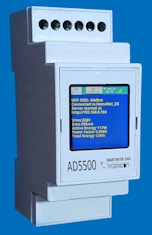Auto-DAN Smart IoT Meter

The EU Commission funded Auto-DAN Horizon 2020 project is focused on producing "a cost-effective technological solution for the self-assessment of actual energy performance of buildings and the products which use energy in buildings". An integral part of this project therefore concerns the accurate, rapid and flexible measurement of electrical energy in buildings, along with a method to try to associate those measurements with the loads that they represent. The objective of mSemicon's Smart IoT Meter, also known as AD5500, being developed as part of Auto-DAN, is to provide this. This solution obviates the need to attempt to rely on standard utility smart meters, the data on which is usually quite difficult to access. The AD5500 is not intended as a fiscal meter; rather, it is geared mainly towards research applications.
The AD5500 Smart IoT Meter is DIN-rail mountable and therefore suitable for use in a standard domestic or commercial electricity distribution panel. It uses an external split-core current transformer as its load sensor, meaning that the main load-carrying cable does not need to be interrupted during installation. It is typically used to monitor incoming power to a building but it can be used for local loads too.
The device reports energy consumption, along with associated parameters such as power factor, up to a rate of one second intervals, and transmits them securely to the cloud through Auto-DAN partner Flairbit's SenseIoty platform. The information is then analysed by other Auto-DAN partners IES and the Technical University of Dublin as part of the wider Auto-DAN project objectives.
Connectivity
The ADD5500 can transmit information in many ways. In typical usage, local wifi is used, allowing large quantities of data - down to one second intervals - to be transmitted. WiFi setup is facilitated through the use of a small high-resolution colour display (with image shown below). Where WiFi is unavailable, backup GSM will be possible, but in this case reduced data reporting is recommended in order to contain operating costs. The GSM module is also equipped with NB-IoT, which will further extend potential coverage. In future it is planned to add zWave and Zigbee connectivity, but these are outside the current scope of Auto-DAN.
The AD5500 is also equipped with on-board local physical layer LoRa. This is used to communicate with other related devices in or near the building concerned, not some public LoRa network. A major benefit of LoRa is its much farther reach than, say, WiFi meaning that devices dispersed around a building, and even outside, are more likely to be more connectable than they would were WiFi used.
The AD5500 also boasts an on-board webserver function. It is possible to observe the status of measurements as well as internal register information using a nearby local phone.
Load Identification
The objectives of Auto-DAN centre around knowing in detail how power is being used in a building. The intention of the AD5500 is to assist this process by using load data such as power level, variation in current, power factor, and so on, as well as the knowledge of what loads are really installed in specific buildings participating in the Auto-DAN trials.
Specific Loads
Usually, one of the biggest energy loads in many buildings, and especially homes in northern Europe, is in their heating systems. Often, heating is provided by gas, not electricity. Since some of the benefits of Auto-DAN will manifest themselves as reductions in gas consumption, a parameter that is typically more difficult to measure in real-time than electricity is, a special sensor to monitor the operating status of gas boilers is also being developed as part of Auto-DAN. This device communicates directly to the Smart IoT Meter over the physical LoRa layer, obviating the need for an independent channel to the cloud. There is also provision, similarly over the physical LoRa channel, to communicate with compatible load sensors (similar to smart plugs) placed on strategic loads that may otherwise be difficult to identify. This all means that the reach of the AD5500 Smart IoT Meter can extend without the need for a specific gateway, other than the local WiFI.